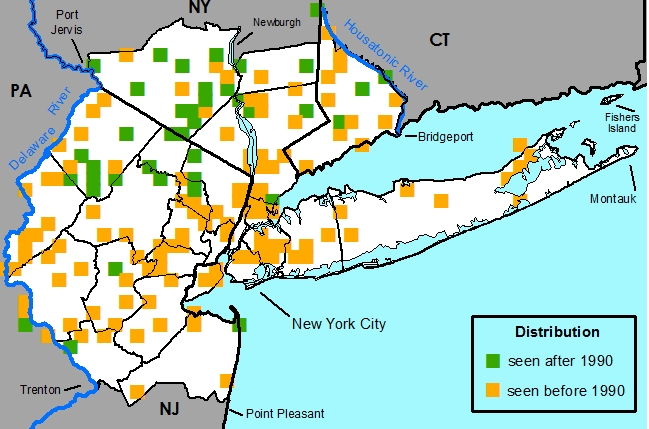Ceanothus americanus L. - New Jersey Tea, Red Root
Common Names
New Jersey Tea, Red RootField Identification
Small deciduous shrub with alternate, toothed, 3-nerved leaves; with clumps of delicate white flowers followed by black, 3-lobed fruits.Food uses
Disclaimer: The information provided here is for reference and historical use. We do not recommend nor do we condone the use of this species for food purposes without first consulting a physician.Dried leaves used as a tea substitute.
Medicinal uses
Disclaimer: The information provided here is for reference and historical use. We do not recommend nor do we condone the use of this species for medicinal purposes without first consulting a physician.Used by Native Americans to treat many maladies including: gastrointestinal problems, toothache, shortness of breath, skin problems, cough, snakebite, and as a laxative and mouth wash.
Other uses
Moerman,1998 Brizicky,1964This species is occasionally used in landscape plantings. Native Americans used the roots as fuel for fire during buffalo hunts.
Nomenclature
Ceanothus americans L., Sp. Pl. 195. 1753.
Ceanothus trinervius Moench, Methodus 651. 1794.
?Forrestia thyroides Raf., in Med. Repos. New York, hex. 2, 3: 422. 1806.
Canothus herbaceus Raf. in Med. Repos. New York, hex. 2, 5: 360. 1808.
Ceanothus perennis Pursh, Fl. Amer. Sept. 1: 167. 1814.
Ceanothus officinalis Raf., Med. Fl. 2: 205. 1830.
Description
HABIT Perennial, deciduous shrub, phanerophytic, monoclinous, 1 m tall; roots dark red.STEMS Main stems ascending or erect, round. Bark smooth, not exfoliating, brown or dark green. Branches erect or ascending. Twigs brown or dark green, not odoriferous, terete, 1.5-4 mm in diam., smooth, with short and unbranched hairs, erect or spreading, white, sparse or dense, distributed throughout, glabrescent, eglandular. Pith light brown or white, round, continuous, nodal diaphram absent. Sap translucent.
BUDS Terminal and axillary present, monomorphic, scattered along stem; terminal bud ovoid, pointed; axillary buds 1 per axil, ovoid, pointed. Bud scales dark red or brown, with long and unbranched brown hairs, moderately dense, distrubted throughout, eglandular. Bud scale scars not encircling the stem. Leaf scars half-elliptical, small, slightly raised. Vascular bundle scars 1.
LEAVES Alternate, simple, spiral, 1 per node, spaced somewhat evenly along and divergent from stem. Stipules small, lateral, deciduous, leaf-like. Leaves petiolate, petiole furrowed, 0.5-1.5 cm long, with long and unbranched hairs, erect or spreading, moderately dense, distributed throughout; not glabrescent, sometimes purple-tinged; sessile glands at petiole apex. Leaf blades: abaxial surface light green, adaxial surface green, ovate, bilaterally symmetric, 2-11 cm long, 1 -5 cm wide, membranaceous, base cuneate or obtuse or sometimes sub-cordate, margin serrate, apex of most teeth with dark glands. Apex acute, abaxial surface with long and unbranched hairs, erect or spreading, white, moderately dense, distributed throughout or distributed along midveins. Adaxial surface with long and unbranched hairs, erect or spreading, white, sparse, distributed along midveins. Surfaces eglandular; 3-nerved at base. For a review of the anatomy of the leaves see Gemoll, 1902(in German).
INFLORESCENCES Bisexual, compound, axillary raceme-like thyrses. Peduncle 2-14 cm long, progressively longer from top to bottom. Rachis present. Bracts sessile, minute, caducous, dark red or brown, glabrous, occasionally with dark red glands. Pedicel 3-7 mm long, glabrous, eglandular, white.
FLOWERS Serotinous, bisexual, with sepals and petals readily distinguishable from one another, 5-merous, fragrance absent. Calyx actinomorphic, of fused sepals, deciduous, abaxial and adaxial surfaces white, glabrous. Sepal lobes 5, triangular, 1 mm long, 1 mm wide, margin entire, apex acute, abaxial and abaxial surfaces glabrous, eglandular. Corolla actinomorphic, of free petals, deciduous. Petals 5, small, margin entire, abaxial and adaxial surfaces white, glabrous, eglandular, hooded, clawed; projecting above sepals; inserted at base of disk. Gynoecium syncarpous. 3-locular, incompletely so at the very base. Stigmas 3, sub-capitate. Style 3- forked, glabrous. Ovary semi-inferior with nectariferous disc encircling the upper portion. Androecium exserted. Stamens 5. Anthers glabrous, eglandular. Filaments straight, white, glabrous, eglandular.
FRUITS Coccarium, black, 3-lobed, 4-5 mm long, 4-5 mm wide, glabrous, eglandular; containing 3 coherent pyrenes.
SEEDS Seeds 3, dark brown, ovoid, 2.5 mm long, 2-2.5 mm wide, glabrous, eglandular, smooth.
Habitat
Usually dry to mesic (occasionally moist) woods, hillsides, rock cliffs, ravines and fields.Distribution
Indigenous to eastern North America.United States -- AL, AR, CT, DC, DE, FL, GA, IA, IL, IN, KS, KY, LA, MA, MD, ME, MI, MN, MO, MS, NE, NC, NH, NJ, NY, OH, OK, PA, RI, SC, TN, TX, VA, VT, WV, WI
Canada -- MB?, ON, QC
New York Metropolitan Region -- Native, historically throughout the metropolitan region, now usually found inland.
Rarity Status
Heritage global rank -- G5Connecticut -- Not listed
New Jersey -- Not listed
New York -- Not listed
Species Biology
FloweringJune [week 1] - August [week 1] (August [week 4])
Pollination
?
Fruiting
July [week 2] - September [week 2] (October [week 4])
Dispersal
Perhaps Endozoochory -- Hesperiphona vespertina (Finch) has been observed eating the seeds, but "It however splits most of the seeds…"
Germination
The seeds have impermeable seed coats as well as dormant embryos. The best germination results have been obtained by first soaking seeds in hot water (170-180 degrees F initially, allowing the water to gradually cool overnight) followed by stratification in moist sand at 41 degrees F for 60 days. Germination is epigeous. Seed stored dry in sealed containers at 41 degrees F showed no appreciable loss of viability after two years.
